Hi! It’s Emma the Intern once again. In this episode of “Comparing Vonnegut Adaptations,” I’ll be looking at the 1972 film Slaughterhouse-Five.
Out of all of Vonnegut’s novels, Slaughterhouse-Five isn’t the first I would choose to adapt into a movie. I’d go with Mother Night or God Bless You, Mr. Rosewater before Slaughterhouse-Five. I wouldn’t want to deal with Tralfamadore, and I wouldn’t want to deal with the unstuck-in-time-ness, either. But someone must have been willing to go where I wouldn’t have, because in 1972, a Slaughterhouse-Five film directed by George Roy Hill hit movie theaters. It’s 1 hour and 44 minutes. It doesn’t star anyone I’ve heard of. And it isn’t half bad. It’s pretty good, actually. Kurt Vonnegut himself thought so too. Slaughterhouse-Five was one of his favorite movie adaptations of his works.
I won’t go over the story too much in this post; you can go any number of places for that if you don’t know it already (my personal recommendation is Vonnegut’s novel Slaughterhouse-Five). Rather, my focus will be on exactly how this movie portrays the book many of us know and love so much. It’s not a 1:1 match. Let’s make that clear from the get-go. But I think there are some compelling reasons why a 1:1 match isn’t the best call for Slaughterhouse-Five.
For starters, the whole autobiographical sandwich mess. Readers of Slaughterhouse-Five will know that Vonnegut opens and closes the book with anecdotes from his own life, especially from writing the novel. The movie makes no mention of those. Frankly, it’s a miracle the movie was able to pull off the concept of being unstuck in time as well as it did, so I think taking Vonnegut out of the picture was wise. Frame stories, even mostly true ones, work better on the page than they do onscreen. It’s part of the reason why any astute film historian can tell you about Frankenstein and his monster (even if they do mix up who’s called what), but ask them about the framing device character of Robert Walton and they’ll guess he’s a cousin of that Wal-Mart family.
So, no Kurt Vonnegut or Bernard and Mary O’Hare in this feature presentation. What else isn’t there? Or, to be more precise, who else? The other major absence in this film is that of Kilgore Trout, our and Kurt’s favorite fictional sci-fi author. Kilgore is Kurt’s self-insert in much of his fiction. That means the Slaughterhouse-Five film excised all possible physical embodiments of the author of the novel. But what it didn’t excise is Kurt’s original idea and story.

The man in the silly light blue outfit is Howard W. Campbell, Jr. He’s also the narrator of Vonnegut’s earlier novel Mother Night.
Let’s go ahead and get to the time jumps, since the movie’s handling of that aspect has the potential to make or break it. The movie opens with Billy Pilgrim typing a letter which explains his time jumps. He, and we, are interrupted by visits the Battle of the Bulge and Tralfamadore. We also find out very early on that Montana Wildhack, Billy’s mate by default on Tralfamadore, knows about his time traveling and knows what Billy looks and acts like when he does it. Although I loved the placement of that scene in the book – it’s almost at the end, which makes it much more powerful – I think the film made a good choice to move it up to the beginning. It helps us better understand what Billy’s deal is, especially those of us who haven’t read the book. (Go do it. Go do it now. I’ll wait here.) (Done? Excellent. Moving on.)
The rest of the film’s time jumps are highly reminiscent of the novel, in spirit if not in complete text accuracy. Like in the book, the war scenes are roughly in chronological order, and scenes of Billy’s home life and Tralfamadore are more scattered. These scenes don’t pull punches, by the way. This movie deserves its R rating. We’re treated to a dying Roland Weary’s foot in all its gangrene-ridden horror, several shots of a topless Montana Wildhack, and heaps of burning bodies in Dresden. Not to mention psychological horrors; after the bombing of Dresden, the camera follows a young German soldier who races through the hollow, charred city and throws himself into his family’s burning apartment building, his fellow soldiers dragging him out crying and screaming, “Papa!”

Montana Wildhack. She’s probably topless. Not that you needed to know that.
And all that is framed by a jolly score composed of jukebox ballads of the forties and fifties and a tinkling piano theme that sounds for all the world like it was written for the winter masquerade of some Austrian aristocrat. I’m certain Kurt approved of the irony.
Oh, and my other concern, the portrayal of Tralfamadore? In the film, Billy can’t even see the Tralfamadorians – something about them only existing in the fourth dimension. Um, okay. However, this does mean we aren’t subjected to actors in blobby alien suits. Or worse, 1970s animation techniques.
There is one other major difference from the novel, but it was a necessary one: Billy is much more of a protagonist in the traditional sense of the word. I didn’t realize how much of Slaughterhouse-Five relies on Vonnegut’s narrative voice until watching this movie. We learn along with Billy, remember along with Billy, travel along with Billy. No Vonnegut as a buffer. No “oh, by the way, he dies.” No “so it goes.” It’s just us and Billy.

Billy Pilgrim and Edgar Derby chatting. They’re better friends in the film than the book.
As a result, many of the character relationships are fleshed out more in the film. Edgar Derby, instead of just being a guy who sits by Billy’s bedside, becomes his friend. There’s a little more exploration of the relationship between Montana and Billy – not much, but a little. And instead of being told about Robert, Billy’s troublemaking son, we are shown him doing actual troublemaking.
Overall? It’s a good film. You should watch it. But maybe not with little kids in the room. And read the book first.



